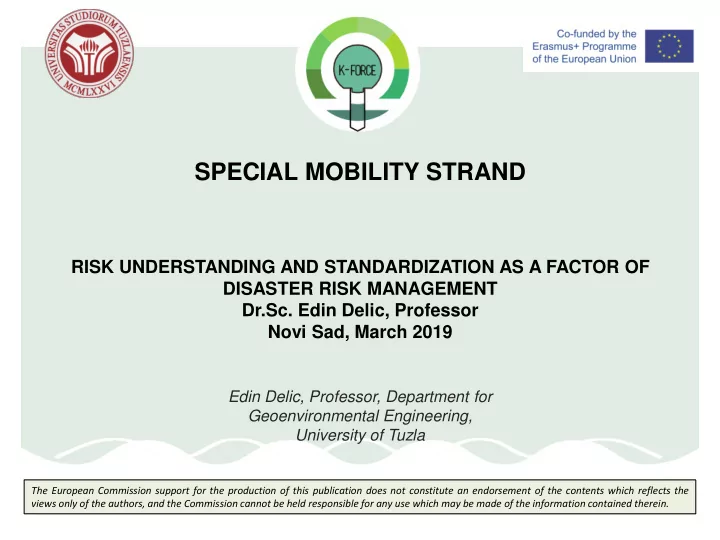

SPECIAL MOBILITY STRAND RISK UNDERSTANDING AND STANDARDIZATION AS A FACTOR OF DISASTER RISK MANAGEMENT Dr.Sc. Edin Delic, Professor Novi Sad, March 2019 Edin Delic, Professor, Department for Geoenvironmental Engineering, University of Tuzla The European Commission support for the production of this publication does not constitute an endorsement of the contents which reflects the views only of the authors, and the Commission cannot be held responsible for any use which may be made of the information contained therein.
Timeline 1972, Stockholm, 1970 1st UN Environment Conference 1980 1990 1992, Rio de Janeiro, Earth Summit-Agenda 1994, Yokohama, 1st DRR Conference, 1995-2005 21 2000 2002, Johannesburg, 2nd Earth Summit 2005, Hyogo, 2nd DRR Conference, 2005-2015 2009, ISO 31000 Risk Management Standard 2010 2012, Rio de Janeiro, 3rd Earth Summit 2015, Sendai, 3rd DRR Conference, 2015-2030 2017, UN 72/218, Disaster Risk Reduction 2020 2030
Avoidance Escasping Transfering Financing
UN Office for Risk Reduction Terminology Challenge https://www.unisdr.org/we/inform/terminology
A Q Disaster - serious disruption ... community or society... due to hazardous events ... exposure, vulnerability ... Iz disaster hazard? human, material, economic and environmental losses Hazardous event? and impacts. Disaster risk governance - institutions, mechanisms, policy and legal frameworks and other arrangements to Risk governance and policy? guide, coordinate and oversee disaster risk reduction and related areas of policy Disaster management - ... responding to and Manage/Respon/Recover? recovering from disasters . Potential? Disaster risk - The potential loss of life, injury, or destroyed or damaged assets which could occur to a Specific period of time? system, society or a community in a specific period of time, determined probabilistically as a function of Deremined probabilistically? hazard, exposure, vulnerability and capacity. Disaster risk management - ... disaster risk reduction Capacity? policies and strategies to prevent new disaster risk, reduce existing disaster risk and manage residual Prevent vs. Reduce vs. Manage? risk, contributing to the strengthening of resilience and reduction of disaster losses . Existing vs.Residual risk
Introduction - Safety - Hazard Risk - - Use this font Logo of the institution
Hazard „ Make ake it it si simp mple, but do no not si simp mplif ify !“ Potential source of harm. P.Van-Impe Risk Combination of the probability of occurrence of harm and the severity of that harm. (ISO Guide 51:1999) “ Effect of uncertainty on objectives” and “characterized by reference to potential events and consequences ”, ISO GUIDE 73:2009 Risk management Coordinated activities to direct and control an organization with regard to risk.
Risk assesment Risk analysis Hazard Risk evaluation identification Risk estimation Name it! Risk = f(Hazard, Probability, Consequences)
From hazard to risk Logo of the institution
Kind of risk? 1. Acceptable risk level: previously agreed and documented 2. Reduced risk: subject of risk reduction strategy 3. Residual risk: subject of continusly risk management Criteria for defining acceptable risk level: 1. Ignoring : accept estimated high risk levels 2. Reacting : react after „ bad things “ happend 3. Normative : obey rules and legislative 4. Pro-active : optimized according to specific criteria 5. Active : ALARP (as low as reasonable practicable)
ESTABLISHING OF CLEAR, SPECIFIC AND QUANTIFIED CRITERIA IS ESSENTIAL ALARP As Low as is Reasonably Practicable
RISK ANALYSIS METHODS … adopt te different conditions and rqrmnts Brainstorming, Interviews, Barrier Analysis, Checklists, PHA – Preliminary Hazard Analysis, TA – Task Analysis, HAZOP – Hazard and Operability Study, SWIFT (Structured “What If” Technique), Scenario Analysis, BIA-Business Impact Analysis, LOPA-Layers of Protection Analysis, FMEA – Failure Mode and Effect Analysis, FMECA - Failure Modes and Effects and Criticality Analysis, ETA/FTA – Event and Failure Tree Analysis, JHA – Job Hazard Analysis, QRA – Quantitative Risk Analysis, HEI – Human Effect Identification HRA-Human Reliability Analysis, Cause-Consequence Analysis, Case and Effect Analysis, Ishikawa Fishbone Diagram, Markov Analysis, Delphy technique, Monte Carlo Simulation, CBA - Cost and Benefit Analysis, Secret Analysis...
FAULT TREE ANALYSIS (ISO 31000)
RISK REDUCTION PARADIGM • Risk reduction appears in title of main disaster risk treatment international frameworks (Hyogo and Sendai frameworks). • Risk reduction is just one part of broad risk treatment procedures. • Family of ISO 31k standards defines risk management as “coordinated activities to direct and control an organization with regard to risk”. Management is much more than monitoring, estimation or control. Risk treatment is defined as “process to modify risk”, with regard to risk treatments that deal with negative consequences are sometimes referred to as “risk mitigation”, “risk elimination”, “risk prevention” and “risk reduction”.
TECHNOLOGICAL, URBAN AND NATURAL FACTORS RISK ASSESMENT
Thank you for your attention Contact info about the presenter: edin.delic@fulbrightmail.org Knowledge FOr Resilient soCiEty
Recommend
More recommend